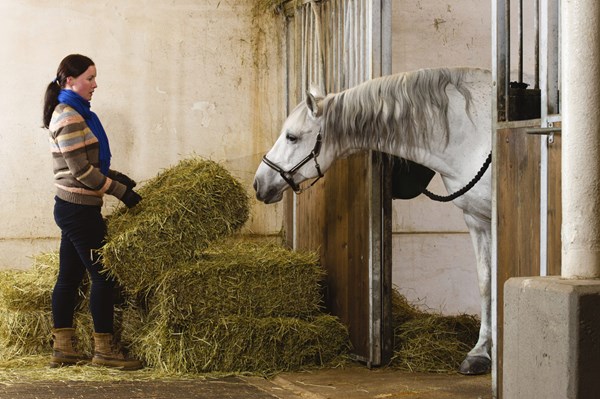 Credit: Thinkstock Steaming represents a management strategy for reducing dust and mold levels and increasing dry matter intake in some hays.
Credit: Thinkstock Steaming represents a management strategy for reducing dust and mold levels and increasing dry matter intake in some hays.Management strategies for horses with respiratory disease include soaking hay prior to feeding. Hay steaming is an alternative to this practice; however, little is known about its impact on forage nutritive values or intake. The objective of a study recently conducted at the University of Minnesota was to determine the effect of steaming on forage quality and intake by horses.
Two alfalfa orchard grass mixed hays were evaluated: a low and moderately moldy hay. Each day, one bale of each hay was steamed for 90 minutes using a commercial hay steamer (Happy Horse Products). Two flakes of steamed or un-steamed low or moderately moldy hay were offered simultaneously to six adult horses in individual hay nets (thee horses per treatment). Horses were fed for five days, then switched hay types for five additional days. Horses were allowed access to hay for two hours and dry matter intake was calculated. Flakes of un-steamed or steamed hay were also agitated in an electric cement mixer, and dust concentrations were recorded every minute for 30 minutes using a tapered element oscillating microbalance (TEOM) sampler.
Steaming increased hay moisture and therefore reduced dry matter to 77% and 71% for low and moderately moldy hay, respectively. In both low and moderately moldy hay, steaming reduced phosphorus content. Steaming reduced water-soluble and ethanol-soluble carbohydrate content by 13% and 27%, respectively, for moderately moldy hay, but had no effect on low-mold hay. Steaming reduced mold levels in both hays. Dust concentrations of moderately moldy hay were reduced by 55%; however, dust levels in low-mold hay were not affected by steaming. Dry matter intake of low mold hay was increased by steaming; however, dry matter intake of moderately moldy hay was not affected by steaming.
For hay with low mold levels, steaming decreased mold levels, increased dry matter intake of the hay, but had no effect on dust level. In moderately moldy hay, steaming reduced mold and dust levels, but did not improve dry matter intake.
Steaming represents a management strategy for reducing dust and mold levels and increasing dry matter intake in some hays. However, steaming should not replace the main goal of feeding good-quality hay (i.e., low in dust and mold).
Co-authors: J. Earing, PhD; M. Hathaway, PhD; C. Sheaffer, PhD; B. Hetchler; L. Jacobson, PhD; and J. Paulson, University of Minnesota and Tennessee Farmers Cooperative.


